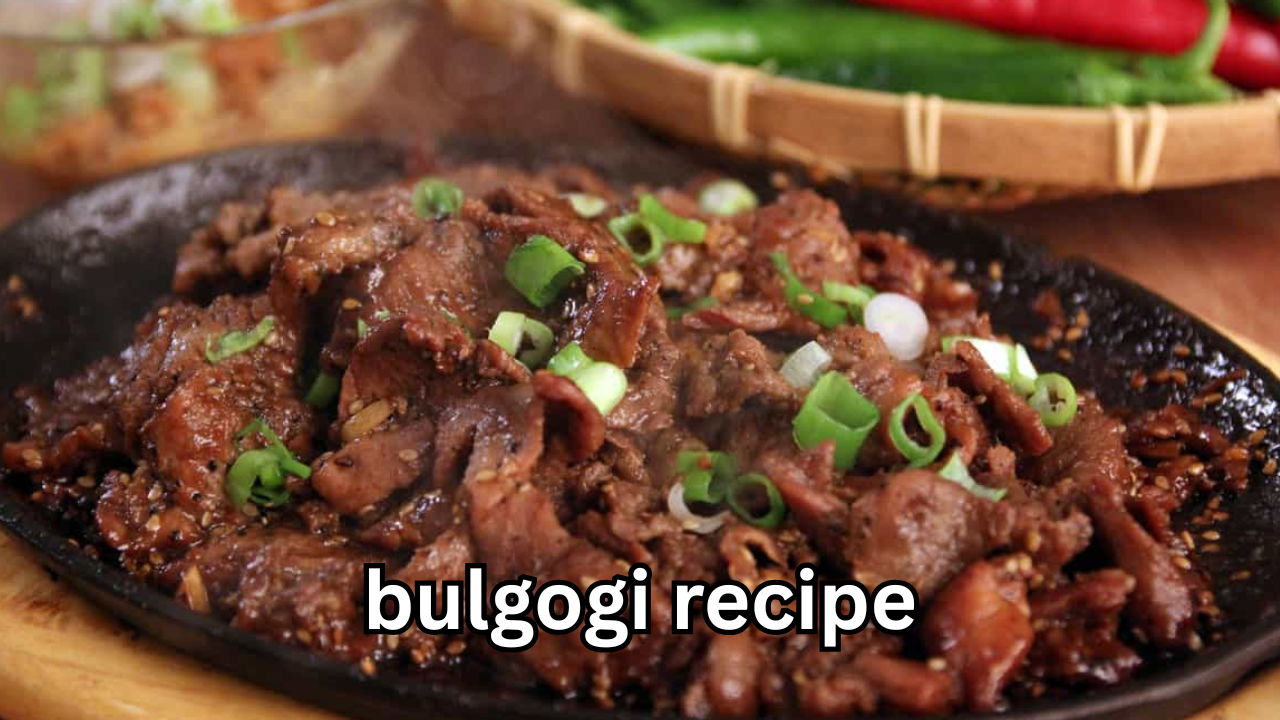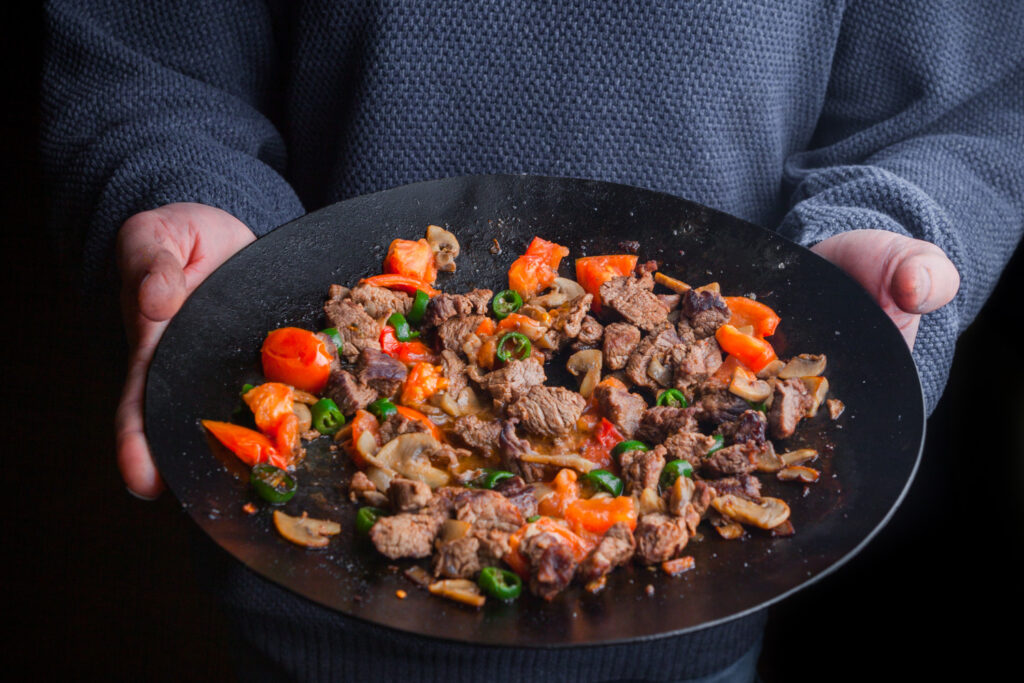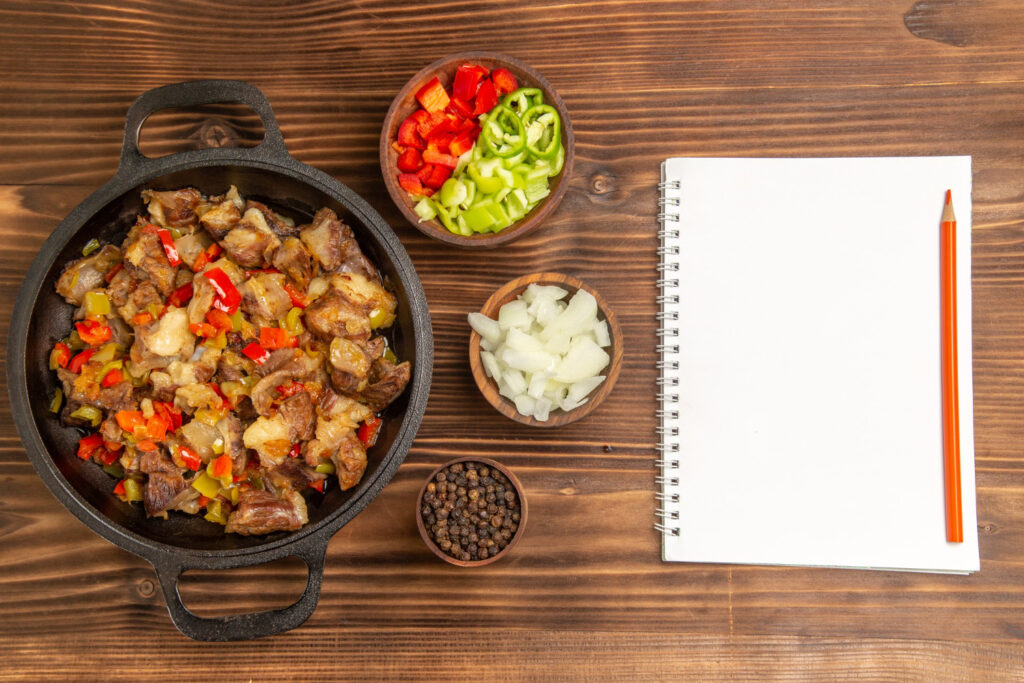
What Is Bulgogi?
Bulgogi Recipe – Bulgogi is a mouthwatering Korean BBQ beef dish known for its perfect blend of sweet, savory, and smoky flavors. The word bulgogi translates to “fire meat,” referring to its traditional cooking method — grilling marinated slices of beef over an open flame. This dish is loved worldwide for its rich taste, tender texture, and aromatic seasoning.
Made with thinly sliced beef soaked in a flavorful marinade of soy sauce, garlic, sugar, sesame oil, and pear, the bulgogi recipe captures the essence of Korean cuisine. Whether cooked on a grill, skillet, or pan, it delivers a taste that’s both comforting and exotic.

History and Origin of Bulgogi
The origins of bulgogi trace back over 2,000 years to Korea’s Goguryeo Kingdom. Back then, it was called maekjeok — marinated beef grilled on skewers. Over time, the recipe evolved into neobiani, which used thin beef slices and later became bulgogi during the 20th century.
Once a royal delicacy enjoyed by Korean aristocrats, bulgogi eventually became a national favorite and a global sensation. Today, it’s served in Korean households, restaurants, and BBQ joints around the world, symbolizing the harmony of Korean flavors.
Essential Ingredients for Bulgogi Recipe
Creating the perfect bulgogi starts with high-quality ingredients. Each element contributes to the dish’s signature aroma and taste.
- Beef: Thinly sliced ribeye or sirloin is ideal for tenderness and marbling.
- Soy Sauce: Adds salty umami flavor and acts as the base for the marinade.
- Brown Sugar or Honey: Brings sweetness and helps caramelize the beef.
- Garlic: Adds a pungent and aromatic depth.
- Sesame Oil: Provides a nutty fragrance and authentic Korean flavor.
- Grated Pear or Apple: Natural tenderizer that sweetens and softens the meat.
- Onions & Green Onions: Add freshness and crunch.
- Black Pepper: Balances the sweetness and enhances the spice profile.
- Sesame Seeds: Used for garnish and extra nuttiness.
Optional additions include mushrooms, carrots, and bell peppers for more texture and color.
Step-by-Step Guide to Making Bulgogi
Step 1: Prepare the Marinade
In a large bowl, mix soy sauce, brown sugar, sesame oil, minced garlic, grated pear, and a sprinkle of black pepper. Stir until the sugar dissolves completely and the flavors combine. This marinade is the key to bulgogi’s mouthwatering taste.
Step 2: Slice the Beef
Choose ribeye or sirloin and slice it thinly across the grain. Freezing the meat for 30 minutes before slicing helps achieve perfect, thin slices that absorb the marinade evenly.
Step 3: Marinate the Meat
Add the sliced beef to the prepared marinade. Mix thoroughly with your hands or a spoon to ensure every piece is coated. Cover and refrigerate for at least one hour, but for the best results, marinate overnight. This step deepens the flavor and tenderizes the meat.
Step 4: Cook the Bulgogi
Traditionally, bulgogi is grilled over charcoal, giving it a smoky and irresistible aroma. But if you don’t have a grill, a hot skillet or pan works just as well. Heat the pan over medium-high heat, add a small amount of oil, and cook the beef in batches until it’s browned and caramelized. Avoid overcrowding to maintain a good seal.
Step 5: Serve the Bulgogi
Once cooked, place the bulgogi on a serving plate and garnish with toasted sesame seeds and chopped green onions. Serve hot with steamed white rice, lettuce wraps, or kimchi on the side for a complete Korean BBQ experience.

Pro Tips for Perfect Bulgogi
- Use Quality Meat: Marbled beef, like ribeye or sirloin, ensures tenderness.
- Don’t Skip the Pear: It’s the secret to soft and juicy bulgogi.
- Marinate Longer: The longer the marination, the deeper the flavor.
- Cook Quickly: Thin slices cook fast—avoid overcooking to retain moisture.
- Grill for Smoky Flavor: Charcoal or gas grills enhance authenticity.
Popular Bulgogi Variations
There’s no single way to enjoy bulgogi. Koreans have created multiple variations of this classic dish:
- Chicken Bulgogi (Dak Bulgogi): A lighter option using chicken breast or thighs with the same marinade.
- Pork Bulgogi (Dwaeji Bulgogi): Made with gochujang (Korean chili paste) for a spicy kick.
- Vegetarian Bulgogi: Uses tofu, mushrooms, or tempeh for a meat-free version.
- Bulgogi Burger: A Western twist with bulgogi-marinated beef patties and buns.
Each version retains the core bulgogi flavor while catering to different tastes and diets.
Health Benefits of Bulgogi
The bulgogi recipe is not just flavorful—it’s also nutritious. Beef provides protein, iron, and essential amino acids, while garlic and onions are rich in antioxidants that boost immunity. The sesame oil contributes healthy fats, and the pear adds natural sweetness without refined sugar.
When paired with vegetables or lettuce wraps, bulgogi becomes a well-balanced meal that’s both healthy and satisfying. You can even control the sodium and sugar levels to suit your dietary needs.

How to Serve Bulgogi
Bulgogi is versatile and can be served in many delicious ways:
- Classic Korean Style: With steamed rice, kimchi, and lettuce wraps.
- In Noodle Bowls: Add bulgogi to stir-fried noodles or ramen.
- As a Topping: Use it for bibimbap (Korean rice bowl with mixed veggies).
- Fusion Ideas: Try bulgogi tacos, burgers, or sandwiches for a modern twist.
Each serving style brings out the unique flavor of this Korean delicacy.
Why Bulgogi Is Loved Worldwide
Bulgogi’s global popularity lies in its balance of flavors—sweet, savory, and umami all in one bite. Its simplicity, adaptability, and quick preparation make it a favorite among home cooks and chefs alike. It’s a dish that connects cultures, offering a taste of Korean tradition with every serving.
From fine-dining restaurants to street food stalls, bulgogi continues to win hearts worldwide, becoming a symbol of Korean culinary excellence.
Final Thoughts on Bulgogi Recipe
The bulgogi recipe is a timeless classic that captures the heart of Korean cooking. With its tender beef, flavorful marinade, and irresistible aroma, it’s no surprise that bulgogi has become an international favorite.
Whether you’re cooking it for a family dinner or a special occasion, this dish guarantees to impress with its rich taste and simplicity. Once you try homemade bulgogi, you’ll understand why it’s loved by millions.
So, gather your ingredients, fire up your pan or grill, and experience the joy of authentic Korean BBQ right in your kitchen.
Also Read: Google Block Breaker: The Ultimate Guide to Google’s Hidden Arcade Game Everyone Is Talking About






1 thought on “Bulgogi Recipe – How to Make Authentic Korean BBQ Beef at Home Easily”
Comments are closed.